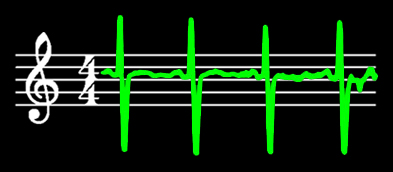 Music Theory tends to focus almost exclusively on harmony, and this blog is no exception, but the rhythmic dimension of music often gets the shaft. Rhythm is the means by which melody and harmony make themselves known. Rhythm may be the most important of the three when determining how to distinguish different musical genres. (Of course, it’s easier to just talk about their respective fashion styles.) Let’s face it, most music sounds the same and relies on the same 7-note diatonic scale, and so it has been for 80,000 years when the oldest bear bone flute was discovered with the same major scale finger-holes that exist today. The ‘feel’ of a musical genre is paramount for deciding whether something is funky, rocking, or jazzy, especially when they use the same scale with small melodic jumps in steps, and the same stacks of harmonies in thirds and fifths. Maybe we avoid it, because ryhthymn is so darn hard to spell.
Music Theory tends to focus almost exclusively on harmony, and this blog is no exception, but the rhythmic dimension of music often gets the shaft. Rhythm is the means by which melody and harmony make themselves known. Rhythm may be the most important of the three when determining how to distinguish different musical genres. (Of course, it’s easier to just talk about their respective fashion styles.) Let’s face it, most music sounds the same and relies on the same 7-note diatonic scale, and so it has been for 80,000 years when the oldest bear bone flute was discovered with the same major scale finger-holes that exist today. The ‘feel’ of a musical genre is paramount for deciding whether something is funky, rocking, or jazzy, especially when they use the same scale with small melodic jumps in steps, and the same stacks of harmonies in thirds and fifths. Maybe we avoid it, because ryhthymn is so darn hard to spell.
Classical music reflects this emphasis on harmony and melody over rhythm, which is probably why it’s so boring. Beethoven is a master of all three dimensions, but where’s the drum beats? Most classical music for centuries has sounded floaty and lofty, noted for its extreme lack of interesting percussion parts. It’s almost exciting for kids who want to play snare drum in music class, until they notice there’s scarcely a notehead or two on their score containing endless bars of rest. Get used to counting, kiddies—that’s where the music lies, between the aching chasms of Cageian silence.
Much of Stravinsky’s appeal comes from his experiments with polyrhythms, but his most famous passage in “Rite of Spring” is a deliberate technical exercise much like math rock music that only seems to appeal to musicians for its cerebral character. A passage played by a genius, full of off-beats and dissonances, signifying nothing (save a Pagan sex-magick ritual).
And what of Jazz? Jazz schmazz! Ting ta-ta ting. The soloist may have got rhythm, and the drummer will drop some surprise bombs on the kick and snare, but for the most part, they are locked into an even measure as dictated by the pinging ride cymbal and the bassline walking in quarter beats.
All music is dance music, as I always say, and today this is overly apparent in the ubiquitous four-on-the-flour mentality heard in everything from indie rock to EDM. It’s all about longing for the comforting heart-beat of the mother womb, beating “lub dub lub dub”, as well as the security of the steady steed—4/4 horse beats. And that’s certainly ok. I get that—the whole Freudian thing. It’s cool and all. But there’s so much more out there, so let us turn our ears towards the consummate musical decade—the proggy fusiony rock ‘n’ roll of the early 70s.
Behold and hearken: Mahavishnu John McLaughlin and his Mahavishnu Orchestra! Below is the opening drum bar to “Vital Transformation” off the 1971 album Inner Mounting Flame (love those New Agey titles!). The beat is in 9/8, played by Billy Cobham, and is just about the tastiest thing ever. But to look at it, we will have to come face to face with the dreaded drum notation. Click on the score to play/stop.
Don’t worry if the above don’t make no sense. Nobody can make sense of this, unless they slow it down to baby-speed and count like an obsessive compulsive walking on a brick sidewalk. Follow the 1’s—they light up on the first beat of every measure. There are 4 measures total. The top Xs stand for the hi-hat, the middle Cs for the snare drum, and the low Ds for the kick drum.
What can I say about this, besides that I want to marry this drum beat? Is it dancey? Well, probably for Sherman Hemsley trippin’ on CIA-grade LSD, dancing interpretively in his Prog Room. But that sounds like a Saw death-trap for most listeners out there.
If this has inspired you to seek out non-normative rhythms, then please do listen to the full Mahavishnu song below. And if you’ve heard it all already before, then I triple-dog dare you to tap along.
Have you riddim? Have you beat? Then feel free to post any exciting odd-time music in the comments below.



